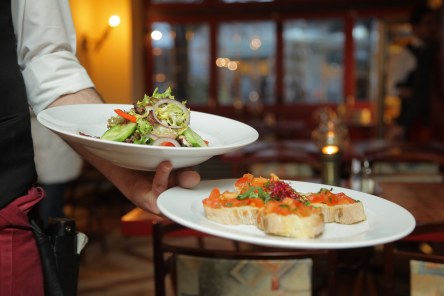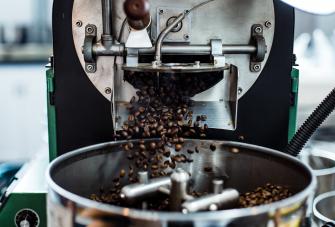What is Table Service?
A practice adopted predominantly by pubs and restaurants, table service has been a staple of the hospitality industry from the outset.
However, despite its ‘staple’ status, this serving method hasn’t received the recognition it deserves. Interestingly though, while many have previously viewed putting service on a plate for customers as an almost unnecessary luxury, the tables are being turned.
In the wake of the COVID-19 pandemic, this process has moved past just pandering to ‘lazy’ patrons, and can in fact be instrumental in pushing your profits. So if you’re ready to overhaul current habits at your hotel or revamp the running of your restaurant, read below to see how much table service can benefit your business.
 What is table service?
What is table service?
The term is used in the restaurant industry to describe a type of service where customers are seated at tables and served by waitstaff.
Unlike counter service, where customers order and pick up their food from a fixed location, venues that provide table service only allow for more interaction between the customer and server.
This often results in a far more personal dining experience, and greater customer satisfaction when executed properly.
Table service can either be ‘table d'hote’, where customers order from a menu and are served a fixed meal, or ‘table à la carte’, where the customer orders directly from the server.
While it's usually offered in restaurants, where the customer's table is served by a single server, table service offered by multiple members of waiting staff, can also be found in cafés and bistros.
Bring something to good the table
It’s important your table service brings something to the table, and we’re not just talking about the food. Simply having table service available in your establishment isn't enough to retain your customers. The quality of your customer service has to be exemplary for the process to serve its purpose, especially where your profits are concerned. There are a few simple steps you can take to ensure your table service is up to par:
- Always greet your customers warmly and ask them how they are doing: This immediately notifies the customer that they’re being considered. As you show them to the table, make sure to take their drink orders and bring them their drinks as soon as possible.
- Don’t keep your customer's waiting ... literally: It's the job of your waiters/waitresses to be constantly attending to customers, so if your guests have to get up to remind you about their order, you've gone wrong.
 Let your guests have a chance to look over the menu: This prevents people from feeling rushed. When you return to take their food orders be sure to let them know when their food will be ready. Keeping your patrons updated on the status of their order can make the difference between a customer coming back or leaving a bad review.
Let your guests have a chance to look over the menu: This prevents people from feeling rushed. When you return to take their food orders be sure to let them know when their food will be ready. Keeping your patrons updated on the status of their order can make the difference between a customer coming back or leaving a bad review.- Make sure to check in on your customers throughout the meal: Provide any refills they may need while doing this. It's crucial to analyse the progress of each table carefully, as checking in too early, too late or too frequently can deter customers.
- Thank them for coming and ask if they would like to make a reservation for their next visit: This makes the customer feel appreciated and also pushes repeat custom - a win-win!
Table service is an important part of the dining experience, and by following these tips, you can ensure that your patrons have a great customer experience every time.
What does this mean for hospitality businesses?
Since the demand for table service has grown exponentially post-pandemic, implementing it into your hospitality business is something you should definitely be considering, regardless of whether you're a restaurant or not.
Table service allows for increased interaction between customers, which results in a more personal dining experience that ultimately helps to increase sales and push repeat custom.
 This style of service also means less time spent waiting in line or at the counter, so your guests will have more time to enjoy their meal and surroundings.
This style of service also means less time spent waiting in line or at the counter, so your guests will have more time to enjoy their meal and surroundings.
If you're looking to open a table service only restaurant, it's important to research the different types of table service that are available.
As implementing this should ideally have positive effects on general productivity, morale, and your margins, it’s crucial to find a service method that best suits your business model and customer base.
A few of the most popular table service practices include:
- Informal silver service: This table service style is often used for breakfast, lunch and dinner. It can be table d'hote or table a la carte, depending on whether customers order from the menu or directly from their server.
- Formal silver service: This table service style is usually only offered at fine dining restaurants where food is served on individual plates and the customer is waited on by multiple members of staff.
- French service: In this serving style, large joints, roast poultry, whole fish, and so on, that have elaborate garnish, are neatly arranged on a platter, presented to the host, taken back to the sideboard, carved, portioned, and served to the guests with service spoon and fork [1].
- Russian service: This table service style is similar to French service, but the food is sent out of the kitchen piping hot when the time is right for it, and offered to diners by waiters, serving from a diner's left side. The waiters also constantly clear away dirty plates and bring new courses to the table [2].
- English service: also known as English Style, Host Service or Family Style, English service is an informal way of table setting, wherein the foods are placed at the middle of the table. Each person is able to just select what they want, and can also request food that’s out of reach to be passed down [3].
- American service: This table service style is used mostly in restaurants where food is served as part of a breakfast buffet and spooned onto individual plates by waiters.
POS systems at your service
If you're unsure of how to go about implementing table service into your business, don’t lose your rag. Having a POS system can help make the process easier.
POS systems are designed to work as a complete business management tool, allowing you to control all vital aspects of your company from one cloud-based system. With your business being automated, managing table service becomes, well, manageable, with human error mostly removed from the equation.
Specific software also allows for integration with a range of business apps, that can take care of table management, reservations, floor plans, and guest lists, as well as other aspects. Epos Now offer a POS solution that includes all the table service software you need, to help you get started with table service in your business.
Receive detailed analysis on the areas that matter to your business:
- View sales analyses on profit margin, cash flow, and other expenses
- Review reports on peak times for better staff scheduling and floorplan management
- Automate stock purchasing so you never miss a sales opportunity
- Integrate with the business automation apps that are right for your business
- Table management and booking system integrations available for an optimised service
If you’d like to learn more about our industry-leading software, request a free callback with one of our experts.




